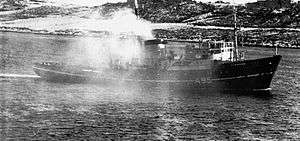RMAS Typhoon (A95)
RMAS Typhoon (A95) was an ocean-going tug of the Royal Maritime Auxiliary Service (RMAS). She was designed for ocean towing, rescue, salvage and fire-fighting. She is notable as being the first ship to leave the United Kingdom ahead of the task force for the South Atlantic during the 1982 Falklands War, and for her fishery protection role in the Cod Wars.[2]
 RMAS Typhoon in Port Stanley during the Falklands War | |
| History | |
|---|---|
| Name: | RMAS Typhoon |
| Builder: | Henry Robb & Co Ltd, Leith[1] |
| Launched: | 14 October 1958[1] |
| Commissioned: | 1960[1] |
| General characteristics | |
| Type: | Ocean-going tug |
| Displacement: |
|
| Length: | 200 ft (61 m)'[1] |
| Beam: | 40 ft (12 m)'[1] |
| Draught: | 13 ft (4.0 m)'[1] |
| Propulsion: |
|
| Speed: | 16+ kts[1] |
| Complement: | 15 (est.)[2] |
| Armament: | None |
| Notes: | Bollard pull 32 tons. Fitted for fire-fighting, salvage and ocean rescue. |
History
The ship was repaired at Falmouth ship repair yard on 19 October 1979,[3] and was also involved in the rescue of the Spanish butane tanker, MV Butaseis, which was aflame and drifting towards the village of Brixton, Devon.[4] The tug stayed as part of the Royal Fleet Auxiliary until included in the RMAS.
Typhoon saw service in the Falklands War from leaving the UK on 4 April 1982 until 20 July 1982 under Captain J N Morris with an all-civilian crew from Portland Naval Base.[6] She also carried 2 Royal Naval Personnel, 1 for comms and 1 medic, they had the distinction of being first to leave and last to return home. Captain Morris and his civilian crew flew back from Port Stanley when Capt Stephens and the relief crew arrived in Port Stanley. Under the command of Captain Bruce Stephens she returned to Portland with her new civilian crew. the 2 Royal Navy Crew remained on board until the vessel docked on 24 September 1982. She was the first ship – albeit a civilian vessel – to leave the UK ahead of the task force, and a member of the crew, the tugs bosun placed the Welsh flag on board RFA Sir Galahad just before Typhoon towed her out to sea to be scuttled by a submarine.[7] During the war, the ship was heavily involved in logistic duties, transferring fresh water to the task force at a rate of 18 tons per trip, and loading part of 17 Brigade onto the MV Norland in preparation for the San Carlos landings.[8] The ship was sold in 1989 and later converted into a trawler in 1992.[6]
References
- Moore, John (1984). Jane's Fighting Ships 1983-84. Jane's Publishing. p. 611. ISBN 0-7106-0774-1.
- Jónsson, Hannes (1982). "Appendix D: The Balance of Power at Sea During The Third Cod War 1975–1976". Friends in Conflict - The Anglo-Icelandic Cod Wars and the Law of the Sea. London: C. Hurst and Co. (Publishers) Ltd. p. 218. ISBN 0-905838-78-5.
- "Ship Repairs (Falmouth)". Hansard. House of Commons. 27 March 1980. Retrieved 7 October 2010.
- "Tanker "Butaseis"". Hansard. House of Commons. 14 January 1980. Retrieved 7 October 2010.
- "RFA Typhoon". Historicalrfa.org. Retrieved 4 March 2018.
- Swinney, Hilda (25 June 2007). "Experience of a lifetime". Dorset Echo.
- "MCHS 0043 – Historical Record – Op Corporate". Movement Control Officers' Club. Retrieved 7 October 2010.